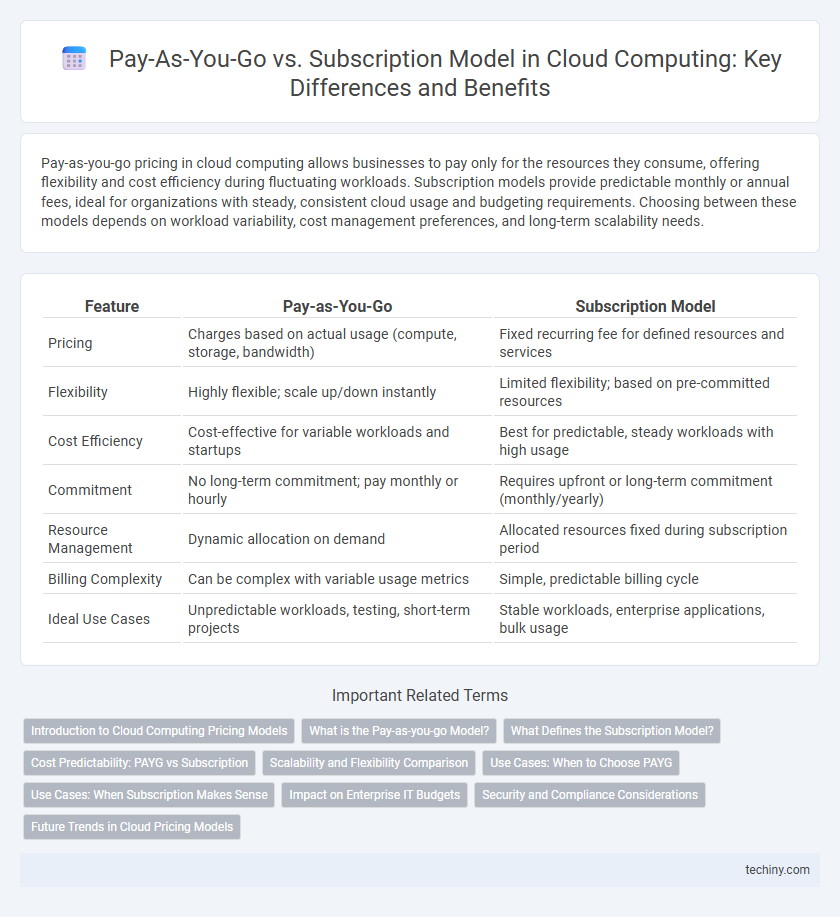Pay-as-you-go pricing in cloud computing allows businesses to pay only for the resources they consume, offering flexibility and cost efficiency during fluctuating workloads. Subscription models provide predictable monthly or annual fees, ideal for organizations with steady, consistent cloud usage and budgeting requirements. Choosing between these models depends on workload variability, cost management preferences, and long-term scalability needs.
Table of Comparison
| Feature | Pay-as-You-Go | Subscription Model |
|---|---|---|
| Pricing | Charges based on actual usage (compute, storage, bandwidth) | Fixed recurring fee for defined resources and services |
| Flexibility | Highly flexible; scale up/down instantly | Limited flexibility; based on pre-committed resources |
| Cost Efficiency | Cost-effective for variable workloads and startups | Best for predictable, steady workloads with high usage |
| Commitment | No long-term commitment; pay monthly or hourly | Requires upfront or long-term commitment (monthly/yearly) |
| Resource Management | Dynamic allocation on demand | Allocated resources fixed during subscription period |
| Billing Complexity | Can be complex with variable usage metrics | Simple, predictable billing cycle |
| Ideal Use Cases | Unpredictable workloads, testing, short-term projects | Stable workloads, enterprise applications, bulk usage |
Introduction to Cloud Computing Pricing Models
Cloud computing pricing models primarily include Pay-as-you-go and Subscription models, each offering distinct cost structures tailored to user needs. The Pay-as-you-go model charges users based on actual resource consumption, providing flexibility and scalability without upfront commitments. In contrast, the Subscription model involves fixed periodic payments, offering predictable expenses and often bundled services for long-term usage.
What is the Pay-as-you-go Model?
The Pay-as-you-go model in cloud computing charges users based on actual usage of resources such as storage, computing power, or bandwidth, allowing for flexible scaling without fixed upfront costs. This consumption-based pricing model enables businesses to optimize expenses by paying only for what they use, contrasting with the subscription model where fixed fees are paid periodically regardless of usage. Providers like AWS, Microsoft Azure, and Google Cloud commonly offer pay-as-you-go plans to support dynamic workloads and cost management.
What Defines the Subscription Model?
The subscription model in cloud computing is defined by a fixed, recurring fee paid at regular intervals--monthly or annually--granting users continuous access to cloud services regardless of usage volume. It offers predictable budgeting and steady revenue for providers but can lead to paying for unused capacity when consumption fluctuates. This contrasts with pay-as-you-go pricing, where charges correlate directly with actual resource utilization, optimizing cost efficiency for variable workloads.
Cost Predictability: PAYG vs Subscription
Pay-as-you-go (PAYG) cloud computing offers flexible cost management by charging only for the actual usage, making it ideal for variable workloads but less predictable in monthly expenses. Subscription models provide fixed, predictable costs through monthly or annual fees, enabling easier budgeting but potentially leading to overpayment during periods of low usage. Organizations must weigh the trade-off between cost predictability and flexibility to optimize their cloud investment strategy.
Scalability and Flexibility Comparison
Pay-as-you-go cloud computing models offer superior scalability by allowing businesses to instantly adjust resource usage based on real-time demand without long-term commitments. Subscription models provide predictable costs and ease of budgeting but can limit flexibility due to fixed resource allocations and contract durations. Enterprises seeking dynamic workload management typically benefit more from pay-as-you-go plans, which enable seamless scaling and efficient cost control.
Use Cases: When to Choose PAYG
Pay-as-you-go (PAYG) cloud computing is ideal for businesses with unpredictable workloads or seasonal demand, enabling cost-efficiency by paying only for actual resource usage. Startups and development teams benefit from PAYG by scaling resources dynamically during project phases without long-term commitments. Enterprises running batch processing or testing environments also leverage PAYG to optimize operational expenses and avoid over-provisioning.
Use Cases: When Subscription Makes Sense
Subscription models in cloud computing are ideal for businesses with predictable workloads and steady resource demands, such as established enterprises running critical applications with consistent usage patterns. Long-term projects requiring stable budgeting benefit from fixed monthly or annual fees, reducing cost variability and simplifying financial planning. Enterprises leveraging reserved capacity for compliance or performance guarantees also find subscriptions advantageous due to enhanced cost control and resource allocation.
Impact on Enterprise IT Budgets
Pay-as-you-go pricing allows enterprises to align IT costs directly with actual usage, minimizing upfront investments and improving cash flow management. Subscription models offer predictable monthly expenses, aiding in budget forecasting but potentially leading to underutilized resources and higher overall costs. Enterprises must evaluate workload variability and financial flexibility to choose the optimal pricing strategy for controlling IT budgets.
Security and Compliance Considerations
Pay-as-you-go cloud computing offers enhanced control over resource usage, enabling organizations to align security measures dynamically with actual consumption, which supports real-time compliance adherence. Subscription models provide predictable cost structures, often including standardized security protocols and compliance certifications managed by the provider, but may lack flexibility to scale security investments based on fluctuating demands. Evaluating regulatory requirements such as GDPR, HIPAA, or PCI DSS is critical to choosing between models, as compliance enforcement and audit readiness can vary significantly with payment frameworks and associated service level agreements (SLAs).
Future Trends in Cloud Pricing Models
Emerging cloud pricing models increasingly emphasize flexibility and cost efficiency, with hybrid pay-as-you-go and subscription frameworks gaining traction to meet diverse enterprise needs. Predictive analytics and AI-driven usage forecasting enable dynamic pricing tailored to real-time consumption patterns, reducing waste and optimizing expenditure. The future of cloud pricing models will likely integrate blockchain technologies for transparent, immutable billing and enhanced user trust.
Pay-as-you-go vs Subscription Model Infographic

 techiny.com
techiny.com